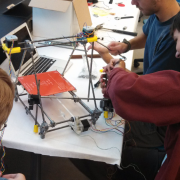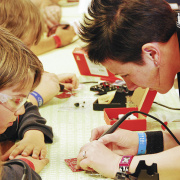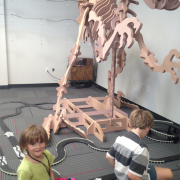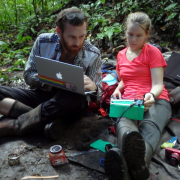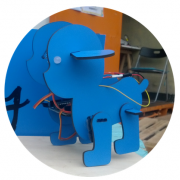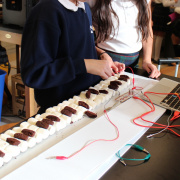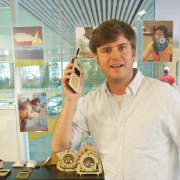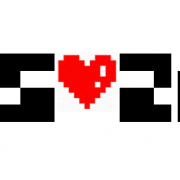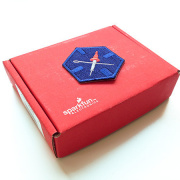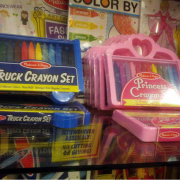b_e_n
Member Since: November 9, 2011
Country: United States
High-school science teachers can radically reduce the cost of building up science labs while giving students opportunities to engage in genuine design processes by introducing them to open-source hardware. A vast collection of free and pre-designed low-cost scientific tools are available, many of which can be printed on a open-source 3D printer, including the printer itself. Not only can students benefit from access to research grade equipment, there are ample opportunities for students to build on, improve, and customize scientific tools as part of their curriculum. In this way the number and value of the open-source hardware designs can expand with student effort, enabling a powerful motivating factor for science education.
Dr. Kristi Pikiewicz discusses introducing some of her therapy clients to soldering as a way to calm and focus themselves. Yet another reason to involve kids in DIY projects?
Garth Sundem, big-time author and GeekDad contributor, came by the new SparkFun HQ with his family. Here's what he had to say about it.
The Hiking Hack is the first of a proposed series of research expeditions investigating the role of situated design for wild animal interaction. This mobile workshop through the Panamanian Rainforest was designed to explore how context shapes the crafting of technology and to probe the limits of constructing and utilizing DIY physical computing systems in harsh environments. It also served as a means of engaging with and reflecting upon the biological, technological and cultural aspects interplaying in modern scientific research.
MakerCamp was a month long camp where makers, designers and mentors from different parts of the world and with varying skill sets came together to work on projects they wanted to dive deeper into. The group of participants flew in from all over the globe last month (August) to hack, make, teach, work together, and document their making process. In the end they came away with a global community of support for prototypes that can be kick-started into real life projects. As SparkFun was a partner in the camp, we wanted to showcase some of the awesome people and projects from the camp last month.
We’ve probably used the word “maker” more times in the last year than we have in the last ten years. It’s pretty evident that making is blowing up. Makerspaces have made their way into blogs on education, hackerspaces are being featured in The New York Times, and a White House Maker Faire was held in lieu of the annual White House Science Fair this year. I think it’s fair to say making is so hot right now.
We've submitted some great proposals to SXSW and we need your help to get them accepted!
We've submitted some great proposals to SXSW and we need your help to get them accepted!
Jaymes Dec returns for the second installment of a series on useful strategies for makers. Jaymes is the Fab Lab Integrator at the Marymount School, a K-12 all-girls independent school in Manhattan and was recently named a “Teacher of the Future” by the National Association of Independent Schools and a Fab Learn Fellow by Stanford University.
As a middle school technology educator who has a Fab Lab for a classroom, I spend a lot of time thinking about useful tips, tricks, and strategies for young makers. Just as we teach developing readers and writers how to skim a text for main ideas or create an outline for an essay, are there similar strategies or techniques that we can model for young makers to help them successfully navigate the making process and develop a maker mindset?
Guest blogger and chair of the 2014 Open Hardware Summit, Addie Wagenknecht breaks down this year's participation call for the summit in Rome, Italy.
SparkFun teamed up with DIY.org, a web community that encourages kids to gain skills in all sort of areas - from astronomy to camping to hardware hacking - to bring a new skill to their site: the fabric hacker.
Deren Guler leads a project called “Invent-abling” focused on creating gender neutral construction kits that inspire people to creatively explore topics in STEM (science, technology, engineering, and math) for children, specifically girls aged 7-13.
HacKidemia is a global organization that runs hands-on STEM workshops for kids in more than 25 countries around the world with 8000 children and 400 mentors. They were asked to bring the project to Africa and launched an indiegogo campaign two months ago: http://www.indiegogo.com/projects/afrimakers. The main intention is to enable African makers -- kids in particular -- to use making and prototyping for solving local challenges like access to clean water, energy and information. SparkFun has donated the materials for 7 maker boxes - enough to support the initial campaign goal to equip each of the 7 hubs with a set of Arduino's, sensors, books, and tools.
SparkFun Inventor's Kit for Photon Experiment Guide
September 3, 2015
Dive into the world of the Internet of Things with the SparkFun Inventor's Kit for Photon.
Photon OLED Shield Hookup Guide
July 2, 2015
The Photon OLED Shield has everything you need to add a small yet crisp OLED screen to your Photon projects. This hookup guide will show you how to get started.
Photon IMU Shield Hookup Guide
July 2, 2015
Learn how to use the SparkFun Photon IMU Shield for your Photon device which houses an on-board LSM9DS1 system-in-a-chip that houses a 3-axis accelerometer, 3-axis gyroscope, and 3-axis magnetometer.
RGB Panel Jumbotron
August 5, 2014
This tutorial will show you how to combine a webcam, a 32x32 RGB LED panel, and a Teensy 3.1 to stream video from the webcam, pixelate it, and display it on the LED panel - LIVE.
Data Types in Arduino
November 6, 2013
Learn about the common data types and what they signify in the Arduino programming environment.
Firefly Jar Assembly Guide
May 14, 2013
Make a soft circuit firefly jar with conductive thread, LEDs, and the LilyTwinkle!
Connecting Arduino to Processing
April 25, 2013
Send serial data from Arduino to Processing and back - even at the same time!
Installing Arduino IDE
March 26, 2013
A step-by-step guide to installing and testing the Arduino software on Windows, Mac, and Linux.
-
I actually did reach out to Becky Stern at AdaFruit for this, but sadly she was unavailable during SXSWedu -- having said that, I don't think there's much doubt that both organizations would love to see more girls and women involved in traditionally male-dominated tech fields.
-
Looks like you are picking the wrong number in the array to pick your serial port -- if you're using a 3 in the line:
String portName = Serial.list()[3];
Try replacing that 3 with a 0, 1, or 2 instead.
-
Is the code above properly terminated with a semicolon? Are your parentheses properly matched and nested? This error occurs due to a syntax error in your code, has nothing to do with your serial port.
